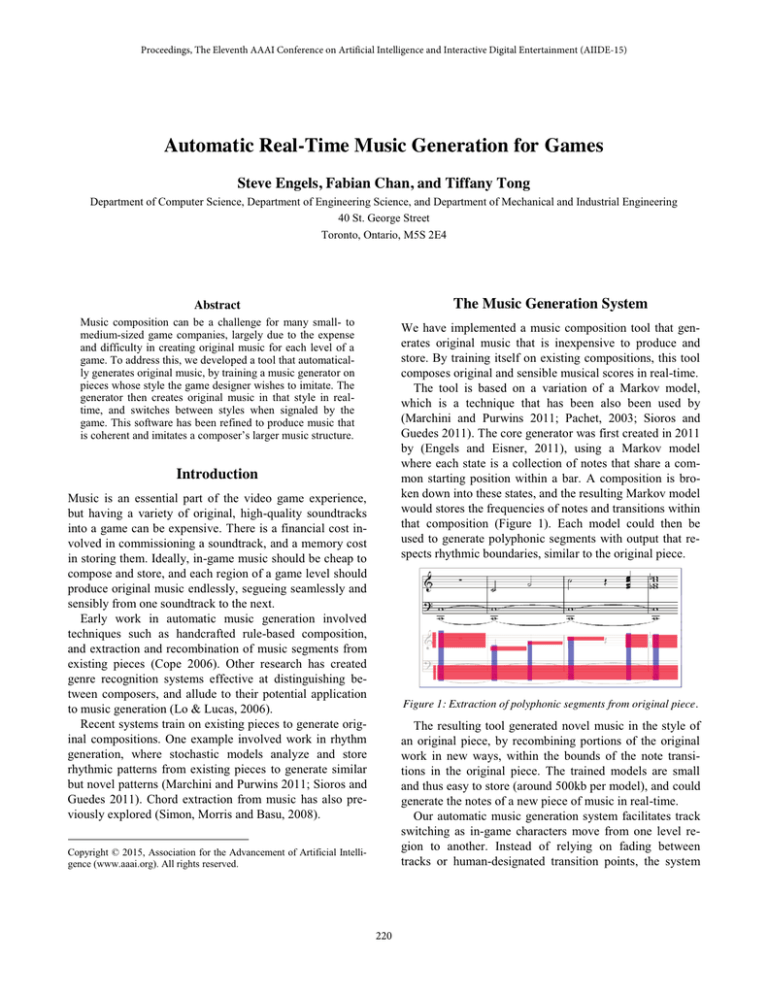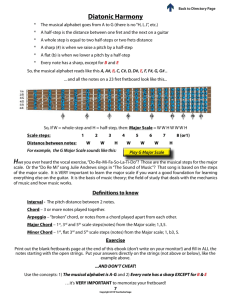
Proceedings, The Eleventh AAAI Conference on Artificial Intelligence and Interactive Digital Entertainment (AIIDE-15)
Automatic Real-Time Music Generation for Games
Steve Engels, Fabian Chan, and Tiffany Tong
Department of Computer Science, Department of Engineering Science, and Department of Mechanical and Industrial Engineering
40 St. George Street
Toronto, Ontario, M5S 2E4
Abstract
The Music Generation System
Music composition can be a challenge for many small- to
medium-sized game companies, largely due to the expense
and difficulty in creating original music for each level of a
game. To address this, we developed a tool that automatically generates original music, by training a music generator on
pieces whose style the game designer wishes to imitate. The
generator then creates original music in that style in realtime, and switches between styles when signaled by the
game. This software has been refined to produce music that
is coherent and imitates a composer’s larger music structure.
We have implemented a music composition tool that generates original music that is inexpensive to produce and
store. By training itself on existing compositions, this tool
composes original and sensible musical scores in real-time.
The tool is based on a variation of a Markov model,
which is a technique that has been also been used by
(Marchini and Purwins 2011; Pachet, 2003; Sioros and
Guedes 2011). The core generator was first created in 2011
by (Engels and Eisner, 2011), using a Markov model
where each state is a collection of notes that share a common starting position within a bar. A composition is broken down into these states, and the resulting Markov model
would stores the frequencies of notes and transitions within
that composition (Figure 1). Each model could then be
used to generate polyphonic segments with output that respects rhythmic boundaries, similar to the original piece.
Introduction
Music is an essential part of the video game experience,
but having a variety of original, high-quality soundtracks
into a game can be expensive. There is a financial cost involved in commissioning a soundtrack, and a memory cost
in storing them. Ideally, in-game music should be cheap to
compose and store, and each region of a game level should
produce original music endlessly, segueing seamlessly and
sensibly from one soundtrack to the next.
Early work in automatic music generation involved
techniques such as handcrafted rule-based composition,
and extraction and recombination of music segments from
existing pieces (Cope 2006). Other research has created
genre recognition systems effective at distinguishing between composers, and allude to their potential application
to music generation (Lo & Lucas, 2006).
Recent systems train on existing pieces to generate original compositions. One example involved work in rhythm
generation, where stochastic models analyze and store
rhythmic patterns from existing pieces to generate similar
but novel patterns (Marchini and Purwins 2011; Sioros and
Guedes 2011). Chord extraction from music has also previously explored (Simon, Morris and Basu, 2008).
Figure 1: Extraction of polyphonic segments from original piece.
The resulting tool generated novel music in the style of
an original piece, by recombining portions of the original
work in new ways, within the bounds of the note transitions in the original piece. The trained models are small
and thus easy to store (around 500kb per model), and could
generate the notes of a new piece of music in real-time.
Our automatic music generation system facilitates track
switching as in-game characters move from one level region to another. Instead of relying on fading between
tracks or human-designated transition points, the system
Copyright © 2015, Association for the Advancement of Artificial Intelligence (www.aaai.org). All rights reserved.
220
transitions when the current model generates a note sequence that the next model might also generate. The new
model continues composing its soundtrack where the previous model leaves off, resulting in a seamless transition.
The Hierarchical Markov Model
More sophisticated music required a hierarchical Markov
model, to produce the different sections of a piece (e.g.
overture, crescendo, denouement). We automatically segmented each piece into sections, trained separate models
for each section, and calculated the transition probabilities
between sections to use in the generation stage.
Our automatic segmenter detects similar recurring passages in a piece, and segments the entire piece into large
component passages. The similarity metric used is based
on a Levenshtein distance calculation, using the pitch, duration, timbre and volume as the main factors for its edit
distance calculation (Figure 2).
Figure 3: Recurrence plot for Hilarity by J. Scott. Notice
small- and large-scale similarity structures marked in red.
Chord Progression as Hidden States
In addition to segmenting music pieces into sections for
training purposes, this tool incorporates hidden states within each section to produce a higher-level progression. After
exploring several options, chord progression were the
strongest predictor for continuous, coherent note generation between sections.
This produced a hidden Markov model (HMM), where
chords served as the hidden states, similar to the work of
(Simon, Morris and Basu, 2008). In cases where the composer had not tagged the training data with chords, our tool
tagged bars automatically with the chord that best matched
the notes and similarly tagged bars from other pieces. The
result created a more natural flow throughout the generated
piece, and also allowed models trained on multiple pieces.
A Mixture of Models
Figure 2: Calculating edit distances between two segments of
Chopin’s Minute Waltz. Vertical dotted lines denote mismatches.
By adding chord label information to each state, the tool
could now train a single model on multiple pieces. This reduces sparseness in each model, while maintaining musical
coherence through the chord structure. Adjustments still
need to be made during training, since pieces may be
slightly incompatible due to key or meter differences. To
address this issue, multiple input pieces were pitch-shifted
to ensure that note transitions were compatible.
A support vector machine classifier with a radial basis
function (rbf) kernel is used on the results of this calculation, to determine matching passages. The classifier is
trained using labeled data from the original piece. Finally,
the segmenter finds the optimal set of segments with nonoverlapping coverage, by optimizing Equation 1:
ܵ ൌ σ௦௧௦ሺ݂ ݕܿ݊݁ݑݍ݁ݎଶ ݈݄݁݊݃ݐሻ
Eq. 1
Discussion
By treating this as an interval-scheduling problem that
uses greedy selection based on the value of S, the result is a
near-optimal segmentation, calculable in polynomial time.
The segmentations are illustrated with a recurrence plot
below, whose major axes represent the piece’s bars, and
darker elements indicate higher similarity (Figure 3). The
segmenter uncovers the largest similar sections, and trains
a Markov model within each section, thus producing music
that is characteristic to the beginning, middle and end of a
piece, depending on its original structure.
The result of this work is a tool that can produce original
music in real-time, in the style of a training piece. It can
change styles from one game region to another, and presents little additional load on the processor. The incorporation of high-level progression with hidden states based on
chord transitions has added a higher level of composition
to the generated pieces. The result is a tool that allows
game studios to have original music for their games, while
minimizing the time, memory or financial cost of requiring
human composers.
221
References
Cope, D. eds. 2006. Computer Models of Musical Creativity. Cambridge, MA: MIT Press.
Lo, M. Y. and Lucas, S. M. 2006. Evolving Musical Sequences with N-Gram Based Trainable Fitness Functions.
In IEEE Congress on Evolutionary Computation.
Engels, S. and Eisner, D. 2011. Automatic Real-Time Music Generation. Game Developers Conference, San Francisco, CA.
Marchini, M. and Purwins, H. 2011. Unsupervised Analysis and Generation of Audio Percussion Sequences. Lecture Notes in Computer Science 6684:205-218.
Pachet, F. 2003. The Continuator: Musical Interaction
With Style. Journal of New Music Research 32:333-341.
Sioros, G. and Guedes, C. 2011. Automatic Rhythmic Performance in Max/MSP. In Proceedings of the International
Conference on New Interfaces for Musical Expression, 8891.
Simon, I., Morris, D., and Basu, S. 2008. MySong: Automatic Accompaniment Generation for Vocal Melodies. In
Proceedings of the SIGCHI Conference on Human Factors
in Computing Systems, 725-734. Association for Computing Machinery, Inc.
222






